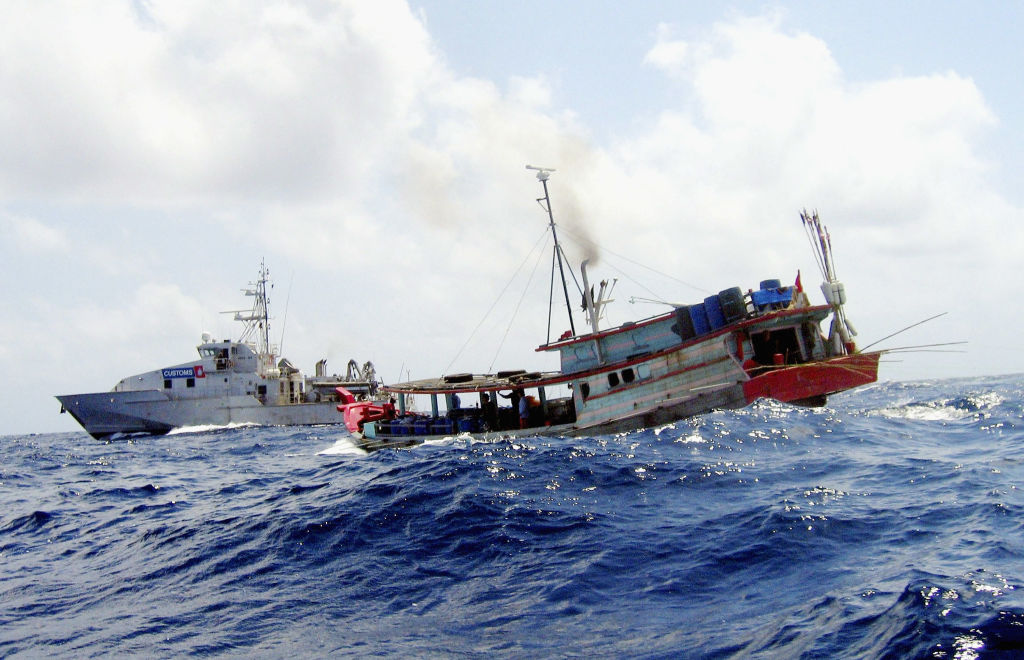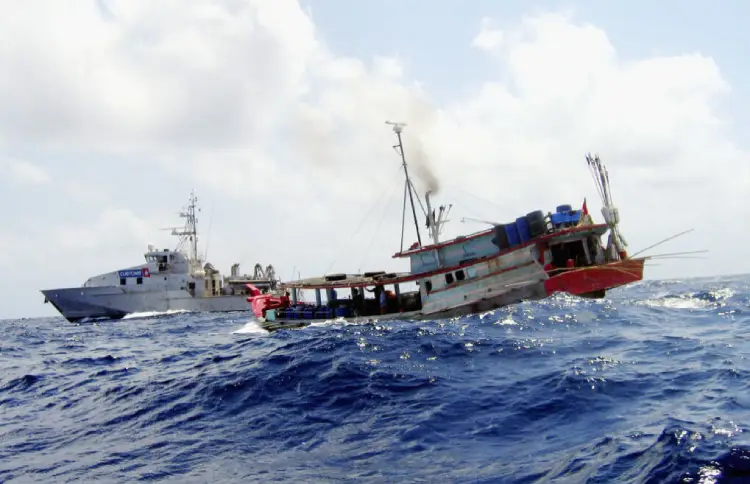
Illegal fishing depletes fish stocks, tears up ocean beds, and decimates food sources for coastal towns and villages. But boats engaging in persistent illegal fishing are commonly guilty of other crimes too, like enslaving workers, human trafficking or smuggling. Until recently, enforcement agencies have been “trying to police the waters like you would police a city”, says Global Fishing Watch (GFW) CEO Tony Long. But tracking platforms like GFW’s that incorporate artificial intelligence are pointing the way to the future of enforcement on the high seas.

GFW was set up in 2017 by joint founders Sky Truth, Oceana and Google. Its AI-powered platform tracks data points including vessel activity, vessel size and engine power, the type of fishing being carried out and the type of gear used. One of the most important data inputs is the Automatic Information System (AIS). Initially installed on ships as an anti-collision device that was transmitted through terrestrial receivers, AIS is now beamed in the form of satellite data from almost every ship. To sort through this morass of data, GFW has begun to train AI algorithms to detect fishing-related patterns so the system “can spot whether a vessel is doing long lining or purse seine-ing or trawling”.
Around 250,000 vessels are transmitting at any one time globally, but using AI, GFW highlights only the vessels believed to be fishing. Long says this will narrow down the number of boats to around 60,000, which he believes still falls short of the true total. To increase the available data, GFW has begun to work with countries to also share what is known as the Vessel Monitoring System, a satellite-based monitoring system which regularly provides data to the fisheries authorities about the location, course and speed of vessels. Generally proprietary, GFW has successfully persuaded countries including Indonesia, Peru, Chile and Costa Rica to share this data – which can provide vital data points where there is less coverage by AIS.
Taking on ‘fish laundering’
What kind of illicit behaviour can this flickering dashboard detect? “[Ships] may be turning their tracker off – they could be doing that in the vicinity of marine-protected areas, or close to vessels that do the transhipment of fish at sea,” says Long. In the former case, this would mean ships sailing through areas that are illegal to fish due to conservation purposes; transhipment vessels are large carrier ships housing refrigerators that collect hauls from smaller fishing boats and return to land so that fishing vessels can remain at sea for longer.
In addition to being illegal, unauthorised transhipments introduce opacity into the supply chain, known as “fish laundering”. “It really makes it difficult to track the source of those fish to see where they came from,” says Scott Edwards, research associate for the Transnational Organised Crime at Sea project. Transhipments allow illegal owners to evade scrutiny at the port. By tracking how close ships get to transhipment vessels, and whether they turn off their AIS when they do, one can map IUU (illegal, unreported and unregulated fishing) hotspots around the globe.
AI tackling tricks used by criminal captains for illegal fishing
But illicitly inclined fishing vessels have plenty of other tricks which are less detectable on a dashboard. The worst criminals flip through a roster of names and “flags” (the country the ship is ostensibly registered to), to evade detection. A ship doesn’t have to be registered to the owner’s country, which means criminal ships shop around for licences from countries known to be unscrupulous in enforcing fishing rules. Typically, the Panamanian flag was in high demand, but Edwards says that now Caribbean nations have taken the top spot. “On paper, they have these massive fleets of ships that have no connection to the country at all – they just paid for a licence,” he says.
GFW helped bring one such vessel to justice in July 2019 – the Panama-flagged MV NIKA, a hulking 750t of rusted metal, with a bow mangled in a fight with a glacier. After a 13,000km journey from the Southwestern Atlantic, where it had been pulled up for a number of fishing infractions by different authorities, including illegal crab fishing, it was finally intercepted by Indonesian patrol boats, in a joint effort with Interpol and GFW. “That’s the sort of level of complexity that you have to get to when conducting enforcement,” says Long.
GFW’s data analysis was also essential to this year’s discovery of why small North Korean fishing boats kept being wrecked on Japan’s shores. “We used all of our techniques that we could to match up data – from radar detections to light detections from space, the vessel transponders – and worked out around 900 vessels are fishing illegally in North Korean waters against sanctions,” says Long, of GFW’s work in partnership with Japan and the Republic of Korea.
These turned out to be Chinese boats trawling for east Asia’s deepwater delicacy, flying squid. Because the boats were depleting fishing stocks along the coastline, flimsy North Korean fishing boats were forced to go further out where their boats weren’t fit for purpose. As a result, “ghost boats” were increasingly being washed up on Japan’s coastline – some still containing the starved remains of their former captains.
But illegal fishing practices aren’t the only thing AI can detect. It may also be able to identify ships that use bonded labour. Slavery is not uncommon in the fishing industry, due to the labour-intensive work and thin profit margins. This is more pronounced in some areas. For example, a 2017 study by the Issara Institute and the International Justice Mission on Cambodian and Burmese fishers in Thailand discovered that 76% of migrant workers in the Thai fishing industry had been held in debt bondage and nearly 38% had been trafficked into the industry.
GFW is partnering with UC Santa Barbara to create algorithms to flag behaviours that could indicate a vessel is using slave labour. Some of these indicators include setting the nets more than twice a day, which would imply the crew is being worked too hard – as would a ship that has been at sea for hundreds of days without landing. “That would indicate that they’re not too bothered about the crew’s welfare,” says Long. He says that GFW has given the details of ships flagged by their experimental model to law enforcement and slave workers have been found on the ships. But Long says it is too early to tell whether this is coincidental or proof that the model works. A forthcoming paper in Science Advances will detail the groups’ research.
Cameras and drones keeping watch on the oceans
Other emerging areas where AI could assist in enforcement is analysing footage from cameras installed on ships. A joint project by the EU, Norway and Marine Scotland, is investigating this. Edwards says it could have a huge application in negating the need for fishing inspectors, who can be corruptible. “The cameras can see what’s been caught and see the conveyor belts,” says Edwards. “And they can use the AI to identify if there’s any irregular patterns.” Drones are increasingly being seen as a useful technology to carry out a similar role.
This could help turn the tide on a globally toxic issue. The US National Intelligence Council argue that IUU accounts for up to one-third of the total global catch, while the Environmental Justice Foundation puts this at least 15%. Of 1,300 commercial species of fish and marine invertebrates, 82% are being removed faster than they can repopulate, according to one study.
In Africa, “fishing communities cannot fish for their own subsistence, because the bigger vessels drain the water of the fish,” says Long. This can have knock-on effects, such as migration away from the coasts into cities, as well as creating nutritional deficits in babies and children. The effect of overfishing one species ricochets throughout the ecosystem, having dire and unforeseen consequences.
Data alone doesn’t solve the problem; the data needs to be acted upon. Long says he believes that the emphasis should be on “rewarding compliance, because that drives better behaviour”. “It’s more cost-effective because you don’t have to chase the bad vessels,” he says. Of a queue of vessels arriving at the port, officials would only have to inspect the ones that didn’t have the right data because these are more likely to have committed a crime.
On the other side, greater enforcement powers and more effective coordination between different agencies is also desperately needed. “At the moment, [fishing] is seen an issue of management, and controlling fish stocks and resources,” says Edwards. The focus has been on surveilling people and making sure they stick to the rules. But at present, the sanctions are very limited, because illegal fishing isn’t viewed as a serious crime. In the UK, for example, marine protected areas are often referred to as “paper parks, because they’re protected on paper”, says Edwards. But this is changing. “The emerging paradigm is to try and treat it as an organised crime, launching investigations, and giving agencies stronger control.” AI will likely play a central role in this new paradigm.






